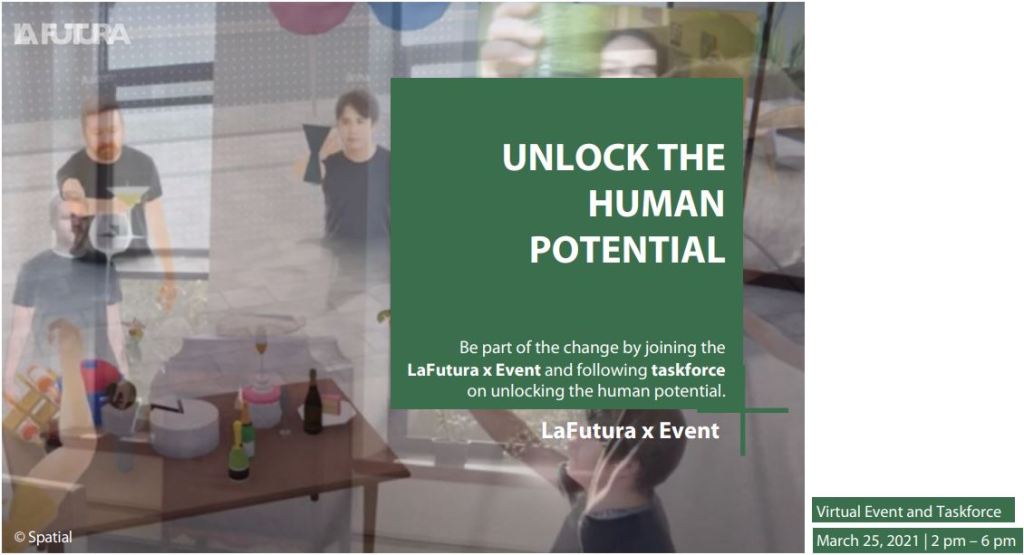Join La Futura task force and contribute to the new paradigms on work models.

The inception of this endeavour started 4 years ago: I was in Saudi Arabia and I sparked a first reflection called, the man and the machine that later evolved to a book chapter.
This is the past.
Let’s look to the future.
The challenges humanity is facing
Working patterns
- Work productivity tend to increase if interconnected tools are implemented, however, there is still a substantial path of convergence ahead, in terms of a user-centric computing model that is adaptive enough into a preferred user interface considering the work context. We a are still far away of: “I make my user interface”.
- Driven by cost pressure, companies are disinvesting in office space and encouraging the workforce to work from home, however, there are signals that not all the work can be done virtually with impact on creativity and relationship networks.
- Reduce cognitive overload by determination of what, when and how information should be presented (format, time, syntax).
Talent skills and inclusion
- Greater ownership over information can improve assessment formative power for a range of the next generation of digital skills to be achieved via adaptive training.
- Shifting social norms and affecting the collective mindset can be more effective towards combat bias that solely focusing on diversity and inclusion training.
New societal normal
- The level on uncertainty related with economic sifts can bring from an irregular adoption of advanced technology and automation to social polarization, populism, government protectionism or the rising of alternative economic models gather interest.
- Are we going to move towards total information awareness, where privacy is gone in exchange of security and automation emerges or are we be organized by creating new “tribes” that emerge with profoundly different views of the society?
There is nothing new on the “new normal”
Change is multidimensional and interconnected
Solely understanding the technological impact on humans and how soon we might be outcompeted is not enough. As such, this task force aims to expand the analysis spectrum to these areas, which present a more complete and diversified understanding of the challenges to be addressed. We are proposing the creation of these working groups to enhance the vision of the future of human potential.
- Job creation or workless future & social protection – as economies become increasingly automated, their general ability to create new jobs needs to be redefined, or to pursue a new welfare model which people will not have a job and economic growth is redistributed. On the other hand, organizations & governments need to be aware of where talent is headed and how they can shape the workforce and ensure a just transition.
- Productivity, and well-being – productivity and satisfaction vary by experience, role, and society context. Not all the work can be done virtually, and there is still a considerable amount of effort to maintain a work-life balance, and the ability for workers to cope with distributed demands for near-immediate availability, out of what had been considered the “working hour period”.
- Human augmentation – people and technology cooperation to enhance the way work is performed, considering human centered design for human capabilities – cognitive and physical augmentation – and intrinsic limitations.
- Virtual universe, twin worlds, and physical spaces – recreation of immersive collaborative work environments that convey a sense of real-world presence, the rise of avatars. The impact on office spaces redesign and collaboration in a hybrid environment and the downstream changes on urbanism and cities regeneration with diminishing presence of buildings.
And last and probably as important is the aspect of diversity and inclusion. I lived in South Africa for 4 years and when I studied the country history, I discovered the meaning of the coat of arms. The motto of the coat of arms, written in the Khoisan language of the San people (a tribe), means: “diverse people unite or people who are different join together”.
- Ethics, privilege, and being inclusive – which is related with influencing the shift in social norms and affecting the collective mindset might be more effective towards combating barriers for people to openly participate in the labor market.
Contribute to what the human potential might become to be
The task force will be organized by these domains. Join the one that you fell you can contribute the most.
Joining the task force will not only expose you to work with a global diversified talent network, but it also helps to be part of a working group that promotes inclusive divergent thinking and ultimately, will address the unique challenge to understand the relationships between the forthcoming societal construct and to explore strategies to enable a future of prosperity.
- You can contribute to a change in society.
- You can influence governments and decision makers on public policies design.
- You can make people to become ready to address the labor shift.
- You can sponsor the workplace a better place, by creating a symbiosis with technology.
Don’t try to predict the future, be the change and make the future happen.
I look forward to work with all of you.
More information at: LaFutura – Global Trend Network
